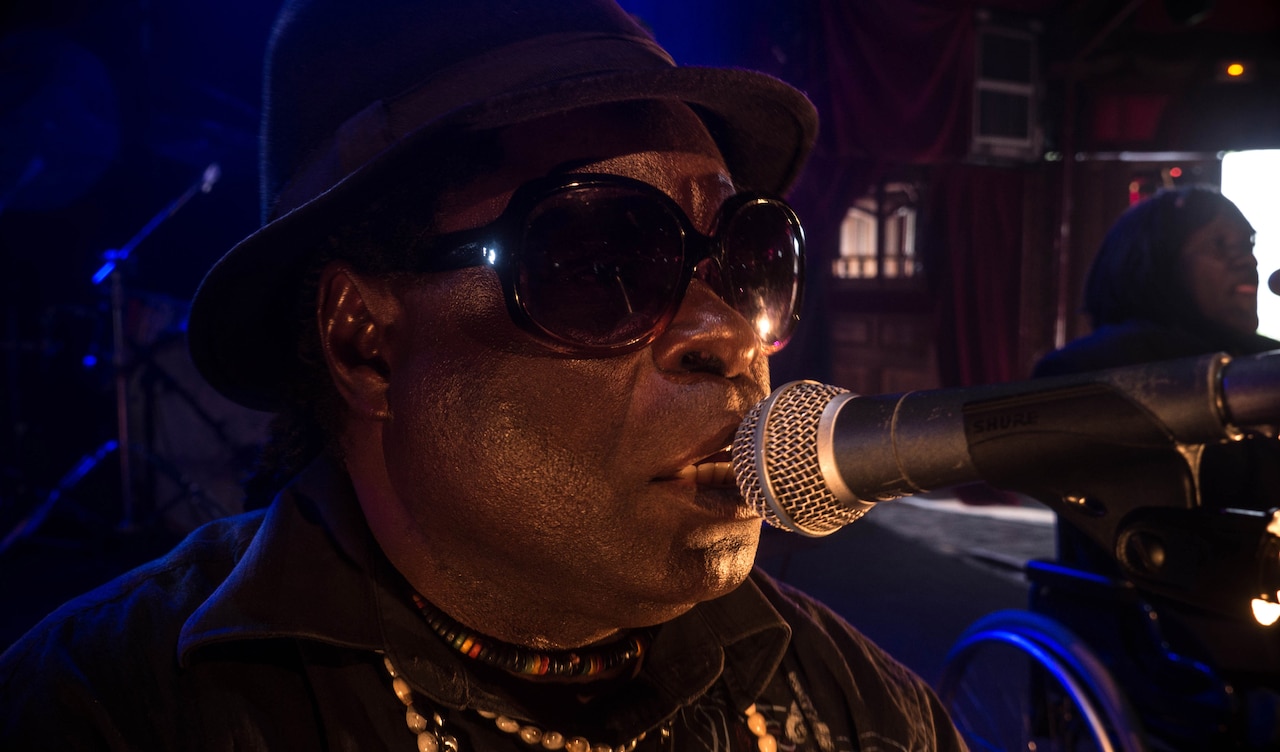
Mbongwana Star: New African Rhythms
“Here, in the streets, it’s the anti-technology thing that works. Everything’s recorded in the red! Sometimes I over-boost mikes that are recording nothing, just to pick up the kind of environment that’s around me now. Can you hear it? There are three TVs going full blast. Distortion multiplies the energy. I love it!”
Doctor L’s grin pixellates as an atrocious Internet connection dices up our Skype conversation. It doesn’t stop him. He seems to revel in the unpredictable zaniness that kicks in when technology breaks down. His words keep coming, delivered with an accent traceable to some obscure point between Paris and Dublin, his lean face a flag of fearless cheek under the ragged mound of dreadlocks that he credits with the ability to disarm any feelings of hostility a lone white man might otherwise attract in the ghettos of Africa.
Doctor L is talking to me from Avenue Kasavubu in downtown Kinshasa. He seems to have found the eternal punk ethic alive and well on the banks of the Congo river, in the raucous swelter-skelter of Africa’s third largest city (equal to London in size), and he’s working hard to bottle it and bring it back to Europe. “It’s not that going to Africa is any big deal,” he says. “The big deal is to try and get something out.”
We changed the rhythm. We built a tempo that can wake up any dancefloor on the planet.
Horror stories about the Congo have been feeding the gorier side of the European imagination since the British Consul Roger Casement published his report on the abuses of the Congo Free State in 1904. The rape of that immense land, witnessed amongst others by Casement and his friend Joseph Conrad, whose classic Heart of Darkness remains one of the most controversial literary statements about Africa ever written by a white man, has continued to this day under both European and African rulers.
It has been perennially justified by the global need, or rather greed, for certain raw materials deemed fundamental to modern existence, rubber initially and then a cornucopia of minerals including copper, gold, diamonds and the rare-earth metals that make our digital “smart” lives possible. The Congo wars of the 1990s and 2000s currently sit at No. 15 in the Wikipedia chart of the most costly conflicts in history in terms of human life, and No. 1 in African history. And yet who, outside Central Africa, remembers them now? Rape, followed by injury, insult, ignorance and forgetfulness: is there any other part of our earth that has been so abused and misunderstood?
But the place has its fans. Among them are the Belgian music producer-manager Michel Winter and the French filmmakers Florent de la Tullaye and Renaud Barret. Toiling away down in showbiz’s steerage class to bring some of Kinshasa’s street-level wonders to the attention of the world, they belong to a rare breed. It takes a special kind of cultural adventurer to see Kinshasa for what it surely is: a place of immense human creativity, ingenuity and style, with the potential to become one of Africa’s creative powerhouses. It seems that Doctor L has just joined their ranks. “The city becomes a drug,” Doctor L says. “Freaks like Michel, like Renaud, like Florent are important. I give the crown to all those guys.”
Renaud Barret and Florent de la Tullaye’s first documentary film, Jupiter’s Dance, was a portrait of the Kinshasa music scene through the prism of a musician and street-level philosopher by the name of Jupiter Bokondji. While they were making that film they stumbled across a bunch of musicians in wheelchairs serenading the denizens of the Kinshasa night: prostitutes, renegade soldiers, hustlers and street kids or shégués as they’re known locally, apparently in mysterious homage to Che Guevara. The band was named Staff Benda Bilili (“the people who see beyond”) after a local beer joint. Barret and de la Tullaye spent the next five years and every ounce of energy and courage they possessed making a film about Staff and the extraordinary underworld they inhabited. It was called Benda Bilili and when it came out in 2010, it became the most successful non-Western music documentary since Buena Vista Social Club, helping to propel the reputations of both band and filmmakers to unimagined levels.
When Staff Benda Bilili split under the weight of their own success in late 2013, their main songwriter “Coco” Yakala Ngambali teamed up with fellow singer “Theo” Nsituvuidi Nzonza to form a new band. At first it was called Trio Mbongwana, then Staff Mbongwana International and finally Mbongwana Star. Mbongwana simply means “change” or “switch” in Lingala, the lingua franca of the Congo River. “In Mbongwana Star, we’ve changed all the rules,” Theo says in one of the band’s early promotional videos. “We’ve decided to take control. We choose to produce our music ourselves. We are all bosses now.”
Theo went further went I interviewed the band in London recently: “We also changed the rhythm,” he said. “We built a tempo that can wake up any dancefloor on the planet.” Talking to the Theo and the rest of the band, it quickly became clear to me that what the band refer to as “rhythm” actually means something broader, something closer to “style.”
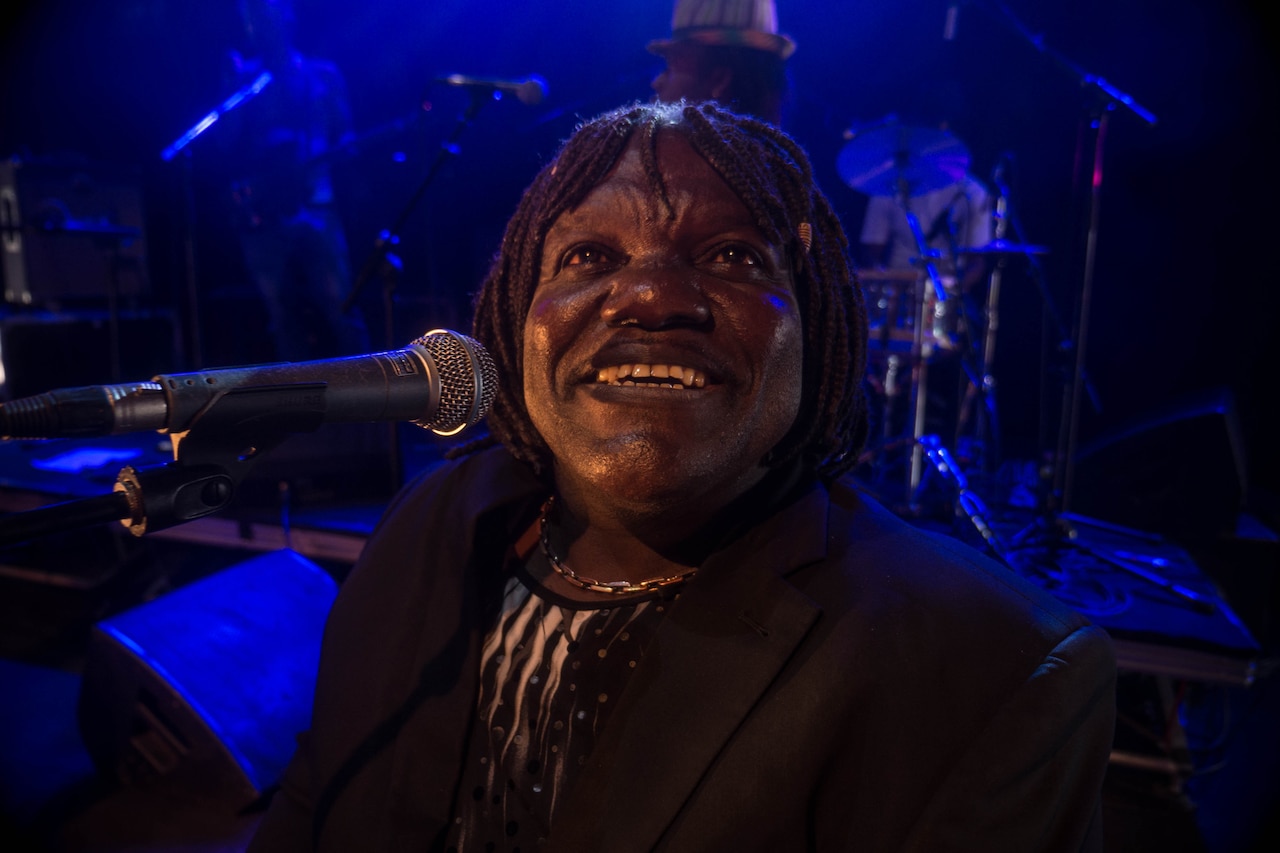
Following the global success and painful breakup of Staff Benda Bilili, whatever style Mbongwana Star chose to play had to be new and surprising. It couldn’t just be a re-run of Staff Benda Bilili minus the brilliance of the young Roger Landu and his self-made satongé (one-stringed tin-can harp). Nor did Theo and Coco want to perpetuate the Dickensian sentiments invoked by their rags-to-riches story and the fact that they’re both handicapped. That was old news. They wanted their music to stand by itself, crutchless and proud.
Both musicians were carrying a heavy load of influences and habits accumulated during long lives hard-lived. That made the task of reinventing themselves harder. Coco was turning 60, and Theo had left his 50th birthday way behind. The Congolese rhumba artists who had nurtured them as children and young men still dominated their creative outlook.
The first Mbongwana Star rehearsals were fairly chaotic. “They bought along this guy and that guy,” remembers manager and exec producer Michel Winter, “mates, members of the family and I don’t know what. And we quickly ended up with a kind of church choir, at least in terms of the voices. It was more like demo stuff than music by a band that was ready to release an album.” According to Renaud Barret, it was Theo who was most aware that what they were doing lacked originality. Barret told him about a friend called Liam Farrell, AKA Doctor L.
Liam is the son of the Irish artist Michael Farrell, who exiled himself to Paris when Liam was still a child. Liam grew into a maverick young drummer and producer on the Parisian hip hop and electro scenes before becoming one of the most innovative producers of music from Africa. Liam had already been collaborating with Kabeya Tshimpangila, AKA Cubain, a percussionist from Kinshasa who seems to have played with everyone who’s anyone in the city’s grassroots music scene, including Jupiter and Staff Benda Bilili. Cubain also happened to be in Kinshasa helping Coco and Theo set up Mbongwana Star. The connections were multiple.
Renaud Barret played Coco and Theo some songs from Black Voices, the album Liam made with the Nigerian drummer Tony Allen back in 2004. The name Tony Allen was already enough to put some heat into the idea of a collaboration. Coco and Theo were fans of Afrobeat, the rhythm that Allen had invented with Fela Kuti back in the late ’60s; Black Voices had put new life into that rhythm, just as it was emerging from the confines of African and “World” music fandom and attracting an entirely new audience of white funksters and hip electro-dance producers. “That’s it!” was Theo’s reaction on hearing the album. “That’s the direction we should go in. Because mbongwana means ‘change’. Because that’s the future.”
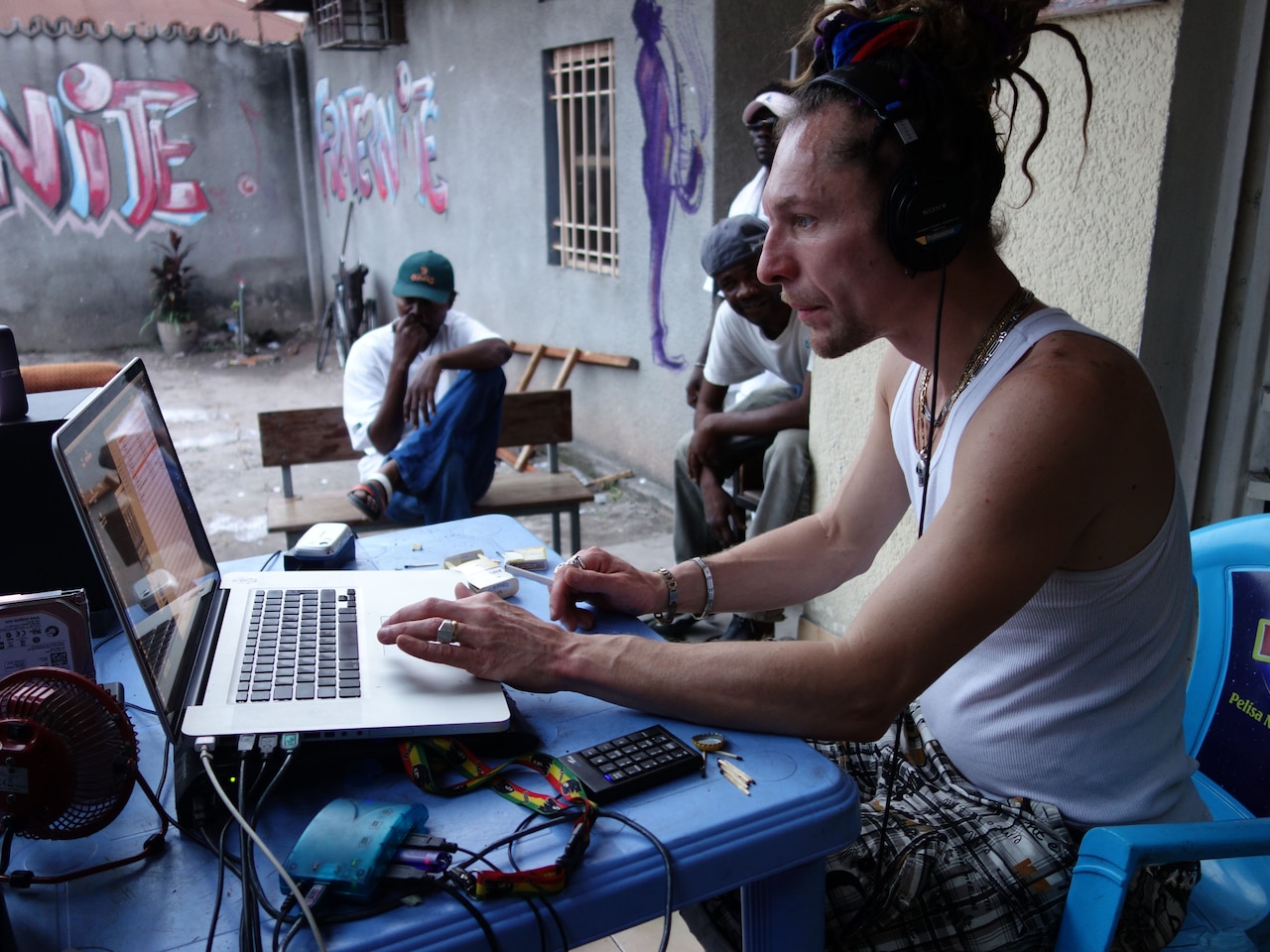
Liam “Doctor L” Farrell and Michel Winter travelled to Kinshasa in early summer of 2014 for the first real recording sessions. Michel had rented a small house in its own yard near the city centre, a parcelle in local parlance, which offered the most basic accommodation. Doctor L slept in a tiny badly ventilated room that baked in the tropical heat, day and night. The grid provided electricity only for short periods, if at all, so a generator had to be hired to run the amps, mikes and recording equipment. Coco’s wife would arrive everyday with the food – sometimes chicken, sometimes fish accompanied by fufu, rice, manioc, beans. It was the kind of set up that Doctor L thrives in.
The music that Coco and Theo played to Michel and Doctor L was a heedless assault of percussion, guitars and voices that was unsure of what direction it should be heading in. There was work to be done. Doctor L began to record as much as he could, chipping away, paring down, honing. “When we started, we were still doing the same ideas as before,” Theo says, “but when Liam got involved he proposed a lot of changes.”
We wanted to try and... get back, in spirit, to the 1970s when Africans were really modern, maybe more so than us.
“We were looking for something fairly rock & roll,” says Winter, whose CV also includes stints as the manager of Staff Benda Bilili and Konono No.1. “We wanted to try and get out of the 100% African, afro-African, straightjacket, into which everybody tries to stick African bands and get back, in spirit, to the 1970s when Africans were really modern, maybe more so than us. I found that Coco already had that in him. People here are a lot more creative than we can imagine; Kinshasa is crawling with creativity. You couldn’t care less if it’s African or not! We just thought ‘Let’s just go for it! Because it’s there anyway. You can feel it in the streets. It exists!’”
“First off, it wasn’t easy,” Theo admits, “but afterward we adapted to the rhythm very well. We changed very quickly…changed rhythm, changed everything. We called it ‘rhumba rock’, because we sing in Lingala, but the rhythm is rock.”
After a few weeks, Doctor L went back to Paris and worked on the material in his studio. He spent the rest of the summer on it. It was an alchemical process, taking raw sketches of sound, stitching them together and transmuting them into something that shone bright and grabbed the ear. The direction was as evident to him in Paris as it had been back in Kinshasa. There was something out there, a street-level Kinshasa aesthetic that had be captured and distilled into musical form. It wasn’t the old rumba or soukous, whose heyday was in the 1970s and 1980s. Or anything traditional or folkloric.

Traces of all those elements were present, but the spirit itself moved beyond all of them. “Coco and Theo, they’re not talking about their village anymore,” says Doctor L. “That can be generations away from them, and they get bored of this kind of caricature. What they have [in Kinshasa] is a certain ‘Yoruban’ way of life.”
Doctor L’s use of the word “Yoruban” is strange. It’s not meant in the strictly ethnic sense of course; Kinshasa is “a cauldron of all the 400 ethnicities of the Congo” according to Renaud Barret, with the Kongo, Luba and Anamongo in pole position and Yoruba holding only a minority presence if at all. To Farrell, “Yoruban” seems to have more of a spiritual meaning related to the dynamic and polyglot freedom of an immense urban space: “Kinshasa reminds me of the New York of the 1980s. In fact, Kinshasa is more New York than New York itself! It’s Yoruban, and from a Yoruban place you can have a gay band, New Wave, punk rock, what the fuck! It’s not griotic, with heritage from your father or your grandfather. It’s more like the European way, like garage music, like when you get ‘Louie Louie’ African style, or James Brown from Ghana, or the like the late 60s and 70s in Lagos, when it was rock & roll man!”
Technology, the Internet, has changed the game in Kinshasa, like everywhere else. The gamut of influences has exploded. “Cable TV is only four or five years old in West Africa,” Farrell continues, “and already, in four or five years, it’s totally changed the kids. They won’t listen to rumba any more, they’ll be listening to Beyoncé. They already know so much more about London and Paris than we’ll ever know about Kinshasa, and that changes what the expectations of people are from music. But it’s good. I mean, fuck it, the world is like that. Everything needs to be communicating; it’s difference of style, of vibe that makes your originality.”
For Doctor L, this opening up of the arteries of communication and influence is inevitable. And positive. Roots may be important, but they can entangle an artist in modes of expression that limit his vision or prevent him being an honest mirror to the life going on around him. “I think Africa deserves, like everybody, to have artists who can take different trips, which may or may not be 100% related to Africa,” he says. “It’s not like we’re busy saying ‘We’re European!’ What does that fucking mean? It’s important that all this magic of art can exist there as well, without it being Iike me saying, ‘OK, I’m going to Ireland to do Celtic music because that’s who I’m supposed to be.’ We’re not talking about Africa here, we’re talking about guys who are doing music.”
When Doctor L’s mixes were heard back in Kinshasa, the effect was one of puzzlement, stupefaction even, followed by escalating excitement and wild dancing. “It was a bit different compared to our rhythm here in Kinshasa,” Theo remembers. “Really, really different. We loved it from the beginning.” Really? From the beginning? “Immediately! It was…WHAAAA?... Oh yes, this is good! Those were rhythms that we could get close to.”
Coco and Theo are ready to run with it if they feel it, whatever it is. It’s not me inventing them. They’re artists.
What about guitarist R9, one of the youngest members of the band? How did he react when he heard the mixes? “Well, it was brand new music,” he said, “but it wasn’t complicated, because it was based on music that we’ve already been hearing for a long time. It was a just a modification for us. For me, it was a joy; I was happy to have created a new style with that. The youth of Kinshasa are more interested by new things. It’s really very important.”
Barret, who was with the band in Kinshasa when Liam’s mixes came through, remembers them dancing all over the place. The songs were on constant replay. Crucially perhaps, the reaction of the band’s entourage was also very encouraging. Fans would gather whenever the band rehearsed in their studio in the Ndjili district. “They would throw flowers at us, support us, shout ‘Mbongwana Star Forward!” remembers Sage, the band’s percussionist and vibe master. “We never expected that. They [the mixes] were great. And they made everyone dance. Without even singing the style, people were already dancing.”
Thanks to a fortuitous meeting at a soirée in London dedicated to music from the Sahara Desert, Michel Winter pressed a copy of the mixes into the hands of Nick Gold, famed founder and A&R man of World Circuit. Love at first sight is rare in showbiz, and the offer of a contract on the basis of a simple demo even rarer. But Gold listened to the mixes on his way home that night, and a deal was on the table within weeks. Not only was Mbongwana Star the first new band that World Circuit had signed in a long while, it was also the first in over 20 years to be produced by someone other than Gold himself and the first to have come from the Congo (Mali and Cuba being World Circuit’s habitual hunting grounds).
By the time Liam and Michel returned to Kinshasa in November, Coco, Theo and their new musicians were busy making the new sound their own. “What’s really interesting with Coco and Theo is that they’re ready to run with it if they feel it, whatever it is,” Liam says. “It’s not me inventing them. They’re artists. This is something really interesting that I love in Africa, and that people don’t talk about a lot: the strength and rapidity they have to integrate whatever comes up.”
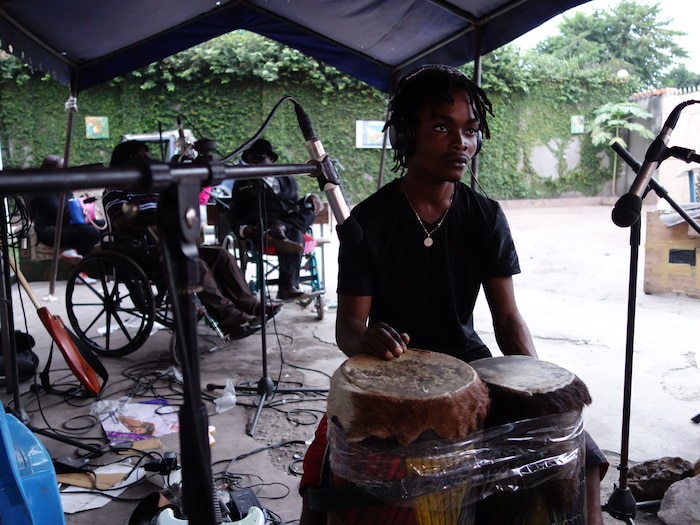
The band line-up was beginning to solidify. First on percussion, then drums, was a handsome young ghetto dude with an intense gaze, a neat splay of short dreads and an easy respectful manner. Forty years younger than Coco, Randy Makana Kalambayi joined Staff Benda Bilili for a while and contributed percussion to their first album Très Très Fort. But before he could board the sweet chariot that carried the band off to Europe and success, Randy was persuaded to come back to his childhood home by his mother to help support the family. He worked as a fare-collector on the busses and a labourer on a building site, a job that turned out to be lethally hard and very badly paid. Eventually he landed back in Kinshasa, and when Coco and Théo decided to quit and set up Mbongwana Star, they invited him along as drummer.
Although Randy is a father now, he still lives in a shelter for the homeless and handicapped, a place that functions, according to Farrell, like an African village lost in the middle of a megapolis. He’s become a master of the Kitéké rhythms of the Batéké plateau, the old name for the country surrounding the “pool” between Kinshasa and Brazzaville. Those rhythms, subtle and strangely familiar, are the pistons of the new Mbongwana sound.
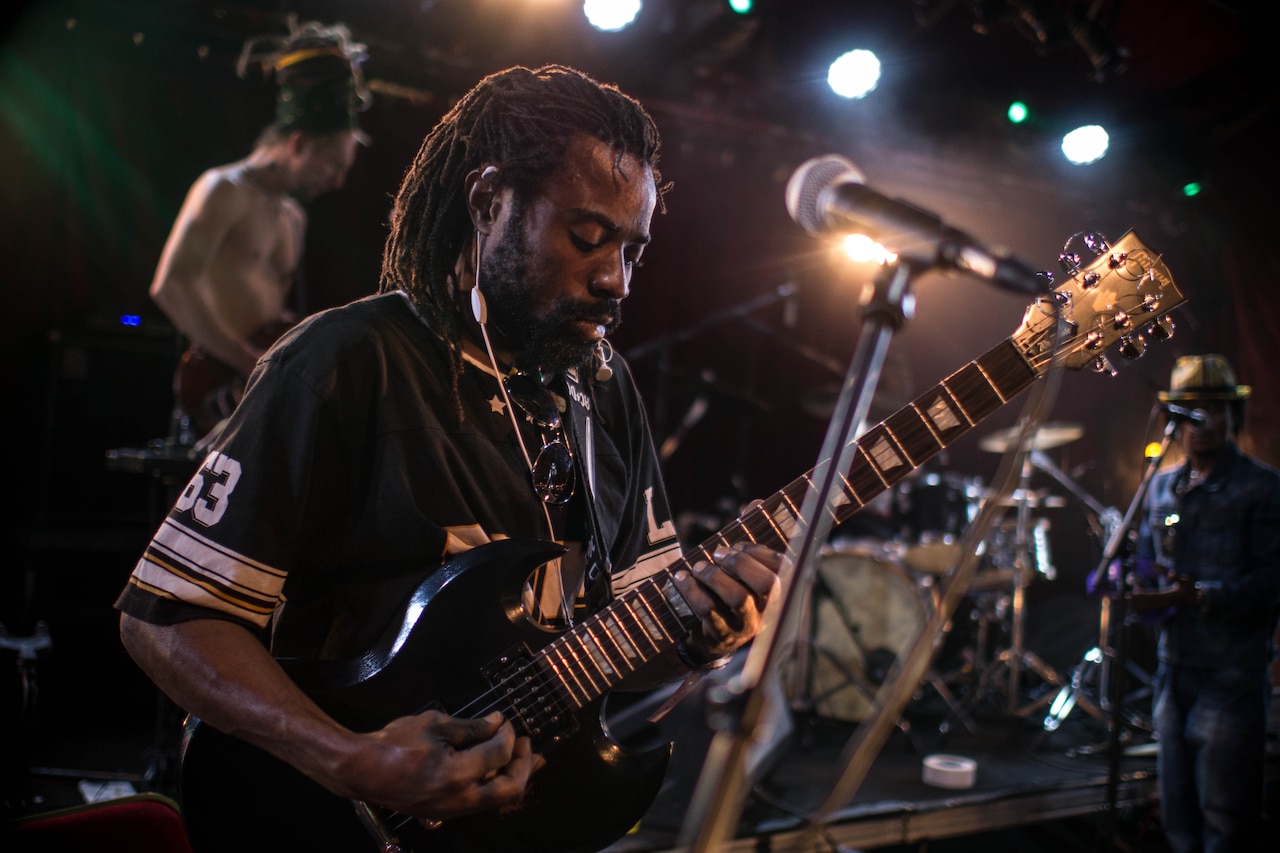
For the pivotal role of guitar, an instrument that has supplied the melodic pulse of Congolese music since the 1950s, Coco and Théo chose Jean-Claude Kamina Mulodi, AKA R9. He’s a thirty-something guitar hero, who long ago pledged his allegiance to Zaiko Langa Langa, the Congolese band who dominated the pan-African soukous boom of the 1970s and 1980s. He’s also a huge fan of AC/DC’s Angus Young, but his stock-in-trade remains the intricately flowing, delicately sparkling Zaiko-esque guitar loops, the ones that send your soul skywards while your feet make love to the ground. “The guitar loops he plays made Liam and I think of techno and electro music from afar,” says Renaud Barret, “so he adapted well to that electro aspect of the project.”
Completing the line-up was Sage. The son of Coco’s wife Marie, Sage is a self-taught percussionist, a tropical cyclone on-stage, a ghetto rude-boy. “Very rock & roll” was Barret’s succinct description of Sage’s lifestyle.
In January 2015, just as Kinshasa was going through one of its periodic spasms of political violence and mayhem following President Laurent Kabila’s unconstitutional attempts to extend his time in office, Coco, Theo, Farrell and the other musicians were holed up in the Hotel Finesse on Avenue Kasavubu, patiently working out how to reproduce the challenging dynamics of Mbongwana’s revolutionary new style live on stage.
Farrell’s position in the project had evolved from that of mere producer to also include bassist, synth and sound FX player, arranger and conceptualiser. He was no longer the white European strategist who stays in his studio, one step removed, trying to make them palatable to the ears of the world. Mbongwana Star was no longer a purely African band. It was a trans-national, trans-ethnic, trans-cultural sound machine, a coalition of black and white, Africa and Europe.
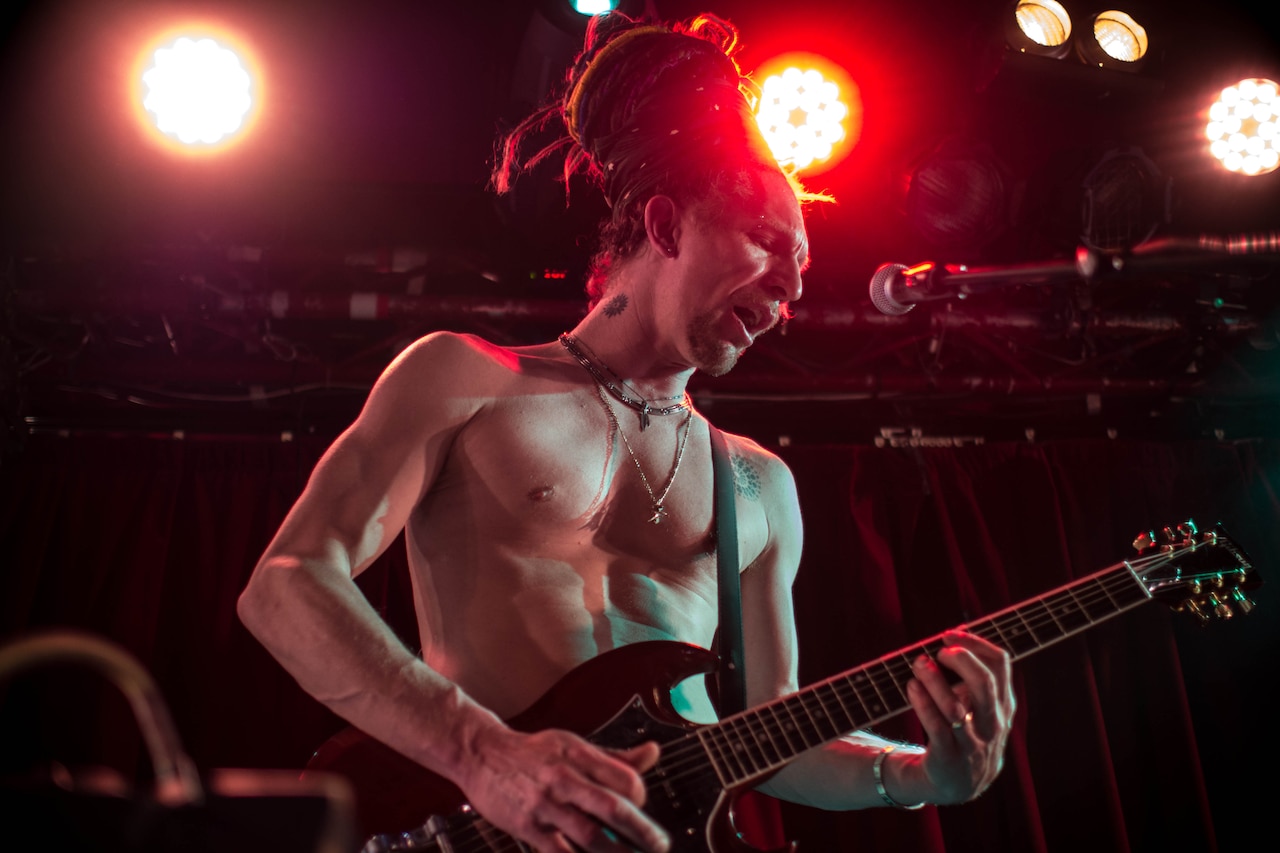
Given the pressures of history and the sensitivity around topics such as race, culture and colonialism, it’s easy to guess at the prevalent line of questioning that Mbongwana Star will be subjected to in the media and the cybersphere. Can a white man play such a prominent role in a black African band? Does it not risk smelling of appropriation, paternalism, cultural colonialism, exploitation, racial arrogance, dilution or all of the above (delete as applicable)?
Not only is Liam unapologetic about the level of his involvement in this project, he also considers the sensitivities and malaise that often surge to the fore in reaction to any cultural collaboration between white Europeans and black Africans to be misplaced, even reactionary: “I think, if you like music, and you like art, colour’s got fucking nothing to do with nothing. That’s what’s great about this world. We all need each other. Let’s stop pretending. I’m very happy that white guys make black guys exist and vice versa. It’s like all these old Analog Africa records. You always need these white mad motherfuckers to dig out all the old dope African music…that’s what’s great about this world. And I’ve got African records where the mix is over the top man! The guitar is 20DBs too strong, but it’s fucking killing! It’s like magic. I never could have done that. So thank you guys!”
Why do I believe him? Several reasons. First the passion and sense of commitment that boosts the voltage of everything he says. Secondly, the time he’s sacrificed to this project, to sleeping in bedroom ovens, plugging into chugging generators, making videos on shoestring budgets, mixing, remixing and remixing the remixed remix, all in search of his grail: a sound that is Kinshasa, right now in 2015. Thirdly, the feeling that Doctor L has moved beyond the naiveté that paints African musicians as angelic beings, imbued with a mystical spiritual power that a “fallen” white man can only admire and serve.
Like musicians everywhere, African musicians are humans who suffer from creative blocks, daft ideas, moments of madness, bad judgement and breakdowns in reason. Should they be allowed to own their own music and determine their own creative path? Of course they should. The answer is so obvious that it makes the question superfluous. But they should also be able to search any place, consider any approach and collaborate with anyone they want to, white or black, European or African, to create something extraordinary.
We don’t see the white, the black, the yellow, the red. We all have red in our veins. We’re together. We play music.
Although there’s black blood in almost every note ever played by a white pop musician since the end of World War I, the traffic has never been one way. Ragtime, jazz, blues, R&B, funk, and soul have all been fed by a minority of white as well as a majority of black cultural influences. In fact, the band with arguably the biggest influence on the evolution of black music in the last three decades, was white. And German!
So, as Farrell suggests, let’s not pretend. The true creative impulse is colour blind. It goes where it wants, talks to who it feels like talking to, collaborates with anybody that takes its fancy. As well as a mutual respect, it’s the brilliance, the originality at the end of the process that counts. “What’s interesting with Coco and Theo is that they’re ready to run if they feel it, whatever it is,” Farrell says. “It’s not me inventing them. They’re artists.”
Coco repays the compliment: “Really, I like Liam. We work well with him. He’s courageous. He’s a real artist is Liam. I recognise that.” And when I ask the band if a white man can play African music, the response is heartfelt, and unanimous: “It’s not colour that plays music,” Theo says. “It’s the spirit. We don’t see the white, the black, the yellow, the red. We all have red in our veins. We’re together. We play music.”
If you listen closely, all the sounds of Kinshasa are in there.
Mbongwana’s aim is to express an attitude, a creative spirit that already exists in Kinshasa. It’s a spirit built on garbage. Renaud Barret has coined a cheeky moniker for it – System K – which he intends to use as the title of a forthcoming feature documentary. It refers not only to Kinshasa, but also to rue Kato, the downtown street that has become the epicentre of the garbage-to-art revolution. It’s also a play on the French term Système D, after the verbs se débrouiller (to get by, to find a way) and se démerder (to find a way without landing in the shit). Roughly, Système D means to manage and survive in the face of poverty and rejection with only your wits and your courage to protect you. The term combines English concepts such as the underclass, the black economy and the daily hustle of survival into one neat tag.
“System K runs the entire city,” Barret explains, “that’s to say, it’s imposed by the current climate, by la débrouille (making do), by all those gestures of daily life that are the creativity of survival. As you know Kinshasa was once the musical capital of Africa. Then everything crashed politically and so [there were] no new instruments or anything. De facto, a whole generation of young musicians with nothing in their hands and nothing in their pockets began making their own instruments, not to get into any kind of found-object art, but just out of necessity. Rue Kato is an artery, about two kilometres long from end to end, and on both sides of the streets you’ve these guys making stuff and creating stuff. They’re creating a new musical style. [They’re] recycled grooves. It makes me think of the first Wu Tang album, very minimalist stuff, all based on recycled materials. There are at least ten creators there, who create loops with tape machines that are themselves reconstructed, and then people come and add stuff, whether it’s a female singer, a rapper, poets. Poverty has created this sound. That’s what’s fascinating... If you listen closely, all the sounds of the city are in there.”
The rue Kato isn’t just producing music: Fashion, sculpture, video, photography, art, jewellery, automata, pedal power contraptions, and motorised vehicles are all rising like the undead from the inexhaustible scrap heap. “Every instrument could be in a museum, with special lighting trained on it,” Barret says with a chuckle, “but it’s all happening in an atmosphere of general indifference, as always happens out there, a kind of enclosed world with no horizon.” In other words, it’s the old curse. Few people know about what’s happening in rue Kato, or the rest of Kinshasa, and few care. Barret hopes that his new film will shine a positive light on this subterranean world.
The video for “Malukayi,” the first single by Mbongwana Star, is a remarkably innovative piece of work by any measure. Doubly so if you consider the tiny budget Barret and Doctor L had at their disposal to shoot and edit it. It features a local character, a happening on two legs called The Congo Astronaut, who wanders around the ghetto in a space suit for no obvious reason other than to be seen and be stylish. When Renaud “premiered” the video on a huge screen at Kinshasa’s École des Beaux Arts, where the video was shot, the response was exhilarating, heartening. “Everybody was saying, ‘That’s it! That’s us!’” Renaud recounts. “And when we played them Liam’s mixes of Mbongwana Star, those guys said, ’That’s our music! We want that! Our artistic imagery is completely incarnated in that music.’” Coco agrees, “I thought it was great. It made me happy.” Doctor L and Barret’s second video “Kala,” is zinging twitching black and white celebration of Kinshasa dance styles, filmed down alleyways, deep in the shanties, out on the drags. They’re working on a whole string of further videos in the same lo-fi System-K spirit.
If the master plan succeeds, Mbongwana Star could be the ones to bring that creative power out of rue Kato, the Beaux Arts, and other parts of Kinshasa. “The Beaux Arts is like a town within a town,” says Renaud. “Mbongwana Star has started rehearsing there and there’s a correlation with visual artists, stylists, people working on logos, etc. It’s this kind of electric movement, this new vibe in Kinshasa that we’re trying to mix in with the music and the image.”
Theo, Coco and the other members of Mbongwana Star are all aware of the talent that exists back home, and the potential ways in which it might transform their visual appearance and live show. But they remain patient: “All that will come bit by bit,” he says. “We have ideas, but we’re starting with what we’re doing right now and then, little by little we can add other things.” The journey ahead may be long, but the time for lift-off has surely come. The Congo Astronaut has waited long enough.
